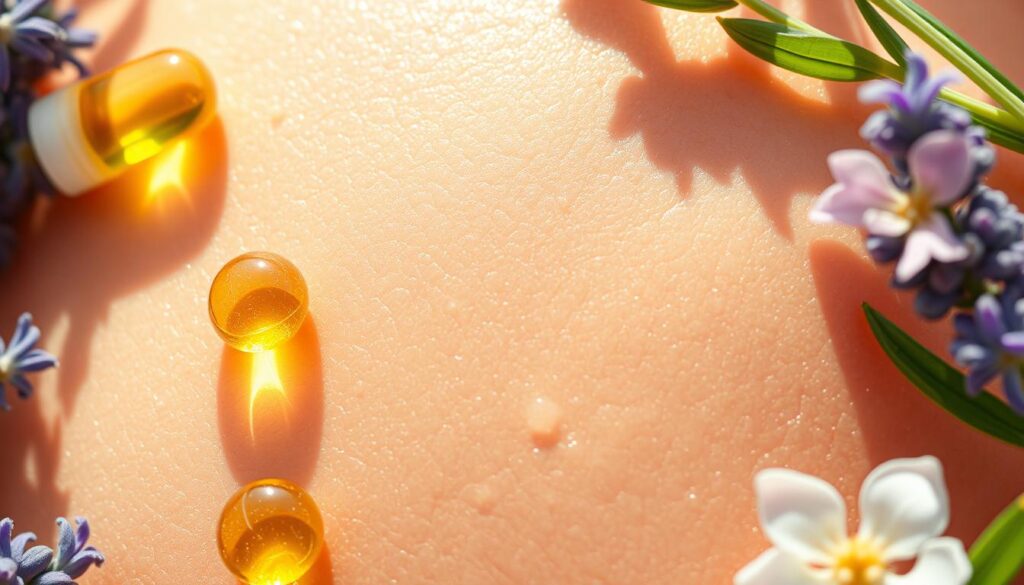Vitamin E is a key player in skin health. It’s a fat-soluble vitamin and a strong antioxidant. It helps keep the skin’s barrier strong, keeps it hydrated, and makes it glow. But how well does vitamin E work for your face? Let’s dive into the science and find out its amazing benefits.
Key Takeaways
- Vitamin E is a vital antioxidant that helps protect skin cells from damage and free radicals.
- Topical vitamin E can help improve skin hydration, reduce signs of aging, and promote a healthy skin barrier.
- While vitamin E may offer some sun protection, it should not replace the use of broad-spectrum sunscreen.
- Vitamin E works best when combined with other skin-loving ingredients like vitamin C for enhanced antioxidant benefits.
- Consulting a dermatologist is recommended before using high-dose vitamin E supplements or products, as excess intake can lead to adverse effects.
Understanding Vitamin E: A Powerful Skin Antioxidant
Vitamin E, also known as tocopherol, is a strong antioxidant. It helps protect the skin from damage caused by free radicals. This vitamin is found in high amounts in the skin, especially in the outer layer.
What Makes Vitamin E Special for Skin Care
Vitamin E is special because it does two important things for the skin. It helps keep the skin moist by absorbing water and trapping it. This makes the skin stay hydrated and soft.
The Science Behind Vitamin E’s Antioxidant Properties
Vitamin E fights free radicals, which can harm skin cells and DNA. By stopping these free radicals, vitamin E protects the skin from aging too fast. Studies show that even a small amount of vitamin E applied to the skin can be very effective.
As we get older, the skin has less vitamin E. This is why it’s key in anti-aging products. Also, using vitamin E with vitamin C can help protect the skin even more from sun damage.

“Vitamin E is the most abundant lipophilic antioxidant found in human skin, and its levels are higher in the epidermis than in the dermis.”
Is Vitamin E Good for Skin? Scientific Evidence and Research
Research on vitamin E for skin health shows mixed results. Some studies say it can make skin more hydrated and strengthen its barrier. But, other studies are not clear, especially about treating acne scars.
A 2013 review found that vitamin E, with other antioxidants, can slow down skin aging signs like wrinkles. But, how much vitamin E helps on its own is still being studied.
In a systematic review and meta-analysis of 20 studies with 1,172 patients, researchers found something interesting. People with skin conditions like vitiligo and psoriasis had less vitamin E than healthy people. This hints that vitamin E might help skin health, but more research is needed.
“Vitamin E has shown efficacy in cases of Hailey–Hailey disease at doses ranging from 800–1200 IU/L, and case reports suggest its potential for managing epidermolysis bullosa at doses of 300–600 IU/day.”
The science on vitamin E for skin health is still mixed. There are some good signs, but more research is needed. We need to understand how vitamin E helps skin health better.
Key Benefits of Vitamin E for Face and Skin Health
Vitamin E is great for keeping your skin healthy and looking young. It fights off early signs of aging and wrinkles. It helps your skin stay smooth and bright by regenerating cells.
Anti-aging Properties and Wrinkle Prevention
Vitamin E is a strong antioxidant that protects your skin from damage. It stops free radicals that cause wrinkles. It also helps your skin make more collagen, keeping it firm and elastic.
Moisturizing and Barrier Protection Effects
Vitamin E also keeps your skin moist and strong. It’s perfect for dry skin because it locks in moisture. It helps protect your skin from harm and keeps it healthy.
Inflammation and Scar Reduction Capabilities
Vitamin E can also reduce inflammation and help with scars. It’s good for skin that’s red or irritated, like eczema or acne. Some people think it can make scars less noticeable, but more research is needed.
Vitamin E is a great addition to your skincare routine. It fights aging, keeps your skin moist, and helps with specific skin issues. Adding it to your skincare can make your skin look healthier and more vibrant.

| Vitamin E Benefits for Skin | Key Mechanisms |
|---|---|
| Anti-aging and Wrinkle Prevention | Antioxidant properties, collagen support |
| Moisturizing and Barrier Protection | Strengthens skin’s natural barrier |
| Inflammation and Scar Reduction | Anti-inflammatory effects, potential scar-reducing benefits |
Different Forms of Vitamin E in Skincare Products
Vitamin E comes in many forms in skincare products. You might see it as tocopherol or tocotrienol on labels. Pure vitamin E oil is thick and often mixed with carrier oils for easier use.
Vitamin E serums and creams are favorites for their ease and effectiveness. They mix well with other good stuff like vitamin C. This combo boosts their benefits.
- Vitamin E is found in avocados, pumpkins, and wheat germ oil.
- It’s great for keeping skin moist as a humectant and emollient.
- Grown Alchemist’s Hydra-Repair Day Cream made skin smoother and hydrated. 98% of users loved it.
Vitamin E skincare tackles many skin issues. It moisturizes, protects, and even helps with scars and aging. Knowing the different vitamin E forms helps you pick the right products for your skin.

Choosing vitamin E oil, serum, or cream can greatly benefit your skin. Look around for the best vitamin E products that match your skin’s needs and your style.
How to Apply Vitamin E for Maximum Skin Benefits
Vitamin E is a strong antioxidant that can greatly benefit your skin. To get the most out of it, knowing the best application time and method is key.
Best Time to Apply Vitamin E Products
Apply vitamin E products at night for the best results. Vitamin E oils and serums take time to absorb. So, nighttime is the best time to use them.
After washing your face, apply a small amount of vitamin E. Use gentle, circular motions.
Recommended Application Methods
- If using pure vitamin E oil, mix 1-2 drops with 10 drops of a carrier oil like jojoba or argan oil before applying to your face.
- For spot treatments, apply vitamin E oil directly to the affected area.
- Vitamin E masks can be left on for 10-20 minutes before rinsing off.
- To avoid clogging pores, use vitamin E treatments no more than once or twice a week.
Regardless of how you use vitamin E, wait at least 20 minutes before lying down. This allows the product to fully absorb. It prevents an oily residue on your pillowcase.

Adding vitamin E to your skincare routine can transform your skin. By applying it correctly, you can enjoy healthier, more youthful-looking skin.
Natural Sources vs. Synthetic Vitamin E for Skin
The source of vitamin E matters a lot for skin health. Vitamin E comes in natural and synthetic forms. Research shows natural vitamin E is better for the skin.
Natural vitamin E is found in foods like sunflower seeds, nuts, spinach, and avocados. These foods make vitamin E easy for the body to use. Synthetic vitamin E, found in some products, is made in labs and might not work as well.
Studies show natural vitamin E is better absorbed by the body than synthetic. For example, 300 mg of synthetic vitamin E is needed to match 100 mg of natural vitamin E in the blood. Natural vitamin E levels in umbilical cords are also three times higher than synthetic, showing the body prefers it.
Natural vitamin E’s better bioavailability comes from its molecular structure. It’s a single stereoisomer, unlike synthetic vitamin E, which is a mix of eight. This makes natural vitamin E easier for the body to use.
When choosing vitamin E products or supplements, look for “d alpha-tocopherol” to ensure it’s natural. Avoid “dl alpha-tocopheryl” as it’s synthetic. This helps you get the most from vitamin E for your skin.

“Studies indicate that natural Vitamin E delivers at least twice the impact as synthetic E in the body.”
Potential Side Effects and Precautions
Vitamin E is usually safe, but it can cause issues for some. If you have oily or acne-prone skin, be careful with vitamin E products. The oil might clog pores and make acne worse. Individuals with sensitive skin might get irritation, redness, or allergic reactions from vitamin E skincare.
Who Should Avoid Vitamin E Products
- People with oily or acne-prone skin
- Those with sensitive skin types
- Individuals taking blood-thinning medications
- Pregnant or breastfeeding women (consult a doctor first)
Signs of Vitamin E Sensitivity
Common signs of vitamin E sensitivity include:
- Redness
- Itching
- Breakouts or skin irritation
If you notice these signs, stop using it and talk to your dermatologist. Vitamin E supplements can also affect certain medications. This is especially true for those with bleeding disorders or who are about to have surgery. Always check with your doctor first.
Vitamin E is great for the skin, but everyone reacts differently. Always do a patch test before adding it to your daily skincare. This way, you can enjoy its benefits safely and effectively.
Combining Vitamin E with Other Skincare Ingredients
Vitamin E is a powerful ally for skin health. But it can be even more effective when paired with other ingredients. This is where the magic happens in your skincare routine.
Vitamin E and vitamin C are a great team. They work together to fight hyperpigmentation, sun damage, and aging signs. Vitamin C keeps vitamin E stable, and vitamin E boosts vitamin C’s power.
Vitamin E and hyaluronic acid are another great pair. Hyaluronic acid hydrates deeply, while vitamin E strengthens the skin. Together, they make your skin soft and resilient.
- Combining vitamin C and ferulic acid stabilizes vitamin C to prevent antioxidant potency loss.
- The trio of vitamins C, E, and ferulic acid offers triple the protective power against UV damage.
- Hyaluronic acid can enhance the hydrating and soothing effects of retinoids, reducing potential side effects.
- Collagen-like peptides can improve skin smoothness, especially around the eye area.
When combining ingredients, start slow and watch your skin. Some, like retinoids, can irritate if mixed. Knowing how vitamin E works with others can lead to amazing skin results.
“The key to unlocking radiant, healthy skin often lies in the synergistic effects of carefully curated ingredient pairings.”
Conclusion
Vitamin E is great for your skin, making it a key part of any skincare plan. It protects your skin from harm outside and keeps it moist and calm. This helps your skin look healthy and young.
Studies show vitamin E helps your skin in many ways. It strengthens your skin’s barrier, reduces wrinkles, and soothes redness. Eating foods rich in vitamin E, like nuts and seeds, can boost these benefits.
Remember, everyone’s skin is different. Always do a patch test before using vitamin E products. Talking to a dermatologist can also help you use vitamin E safely and effectively. With vitamin E, you can improve your skin’s health and look, making it more hydrated and radiant.





